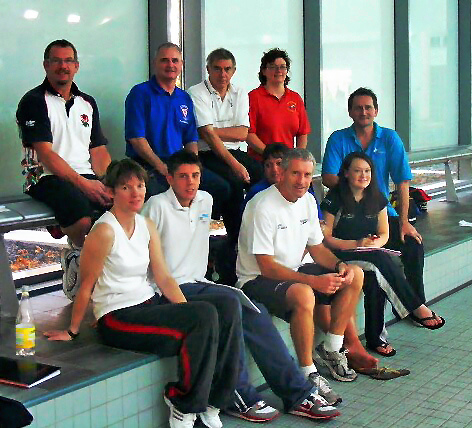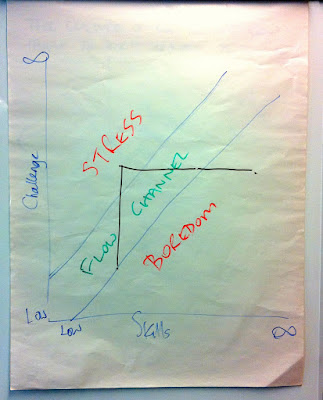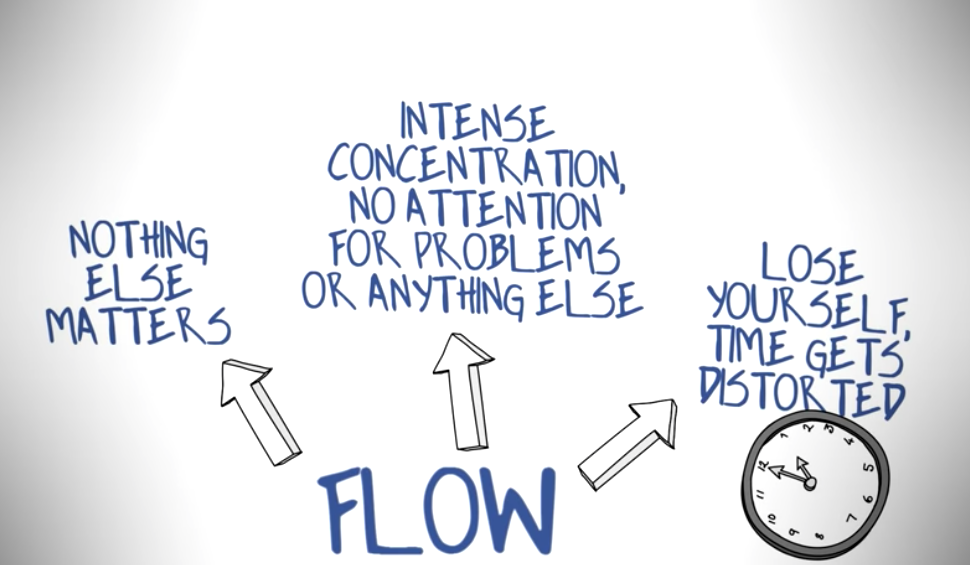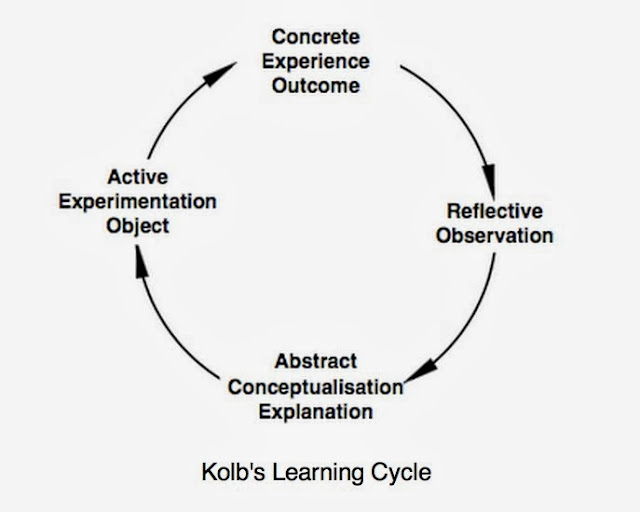
Fig. 1. Kolb’s ‘Experiential Learning Cycle’ reversioned.
I did something …
This is my take on Kolb’s ‘Experiential Learning Cycle’ which I will use to explore what I ‘did’. I ran a creative problem solving workshop. The motivation for attendees was to pick up some creative problem solving techniques, to solve a problem we had with using social media and to do some team building. The objective for me was to crack this problem and to introduce a more creative and collaborative approach to problem solving.

Fig. 2. Coach to Olympians running a workshop - part class, part ‘pool side’
I couldn’t help but draw on experience as a Club Swimming Coach planning programmes of swimming for a squad swimmers and as the ‘workforce development’ running training programmes for our club’s teachers and coaches. Planning and preparation when you are putting athletes in the pool several times a week over months is vital. On a smaller scale this workshop required a schedule, to the minute, with some contingency, allowing you to build in flexibility for both content and timings.

Fig. 3. Planned to the minute - my creative problem solving workshop
The plan was for five to six creative problem solving techniques to be used, top and tailed by, using terms from swimming, a ‘warm up’ and a ‘warm down’. The modus operandi of the Residential School had been to introduce, experience and play with as many creative problem solving techniques as possible.

Fig. 4. As a prop, food and aid memoir a bunch of bananas has multiple uses
‘Bunch of Bananas’ is a creative problem solving technique that suggests that you include in the group a ‘plant’ - a person over whom other’s will slip, like the proverbial banana. My take on this was to introduce two outsiders - a Russian academic who would bring a different take on things and the a mathematician and senior programmer.

Fig. 5. ‘Mother-in-law, Samurai, Tiger’ is a great warm up.
We did a warm up called ‘Mother-in-law, Samurai, Tiger’. This is the team equivalent of ‘Paper, Scissors, Stone’ where two teams face each other and on the count of three, having agreed what their response would as a team, they either 'Tut-tut’ and wag their finger like a mother-in-law, 'growl' and get their claws out like a Tiger, or shout 'ha!' while posing like a Samurai warrior brandishing his sword. This is the ‘warm down’ to stick with the swimming coaching metaphor was to have participants get into the ‘streamlined’ position that swimmers adopt - essentially a stretching exercise.

Fig. 6. Human Sculpture and Timeline are useful ways to have people look at and feel a problem in a different way and from a different angle.
In between we did a mixture of physical and mental activities, including Human Sculpture where one person becomes the sculptor and uses everyone else to form a tableau or sculpture that expresses their talk on the problem. Another was timeline where you imagine looking at the problem from the perspective of the past and future.
Now, stand back …
Standing back I’d say that running a workshop for colleagues has advantages and disadvantages. How would a director or line manager feel about their views being exposed like this. On the other hand if well managed it becomes a team building exercise too.
The challenge is to know what risks to take and how to build in flexibility, not just in timing, but in the kind of activities. This requires that despite the plan you are alert to signals that suggest an activity should be developed or dropped. Workshops and seminars I take have a common element - there is ‘hands on’ activity.The goal is that at the end of the session people feel confident that they could do these things themselves. I’m less comfortable about teaching where the communication is one way - me talking and them taking notes. I value encouraging self-discover and people being on their feet, interacting and having fun.
The workshop was experiential
It was collaborative and iterative, it was problem-based learning that used communication skills.
How did you feel about that ?

Fig. 7. How we like to be ‘in the flow’ rather either bored or stressed from being too challenged. Mihaly Csikszentmihalyi (1975) Mental state in terms of challenge level and skill level.
I felt ‘in the flow’ for most of the time, suitably challenged and never bored. Though anxious and surprised when a colleague gave me a drubbing the day after feeling that they had been tricked into attending. This came as a surprise, the other surprise was how away from their desk and computers the apparently introverted could become so animated and responsive.
I felt like a party planner. I was hosting an event. The atmosphere of controlled enthusiasm would be down to me. I would be, to use a French expression, the ‘animateur’ or ‘realisateur’ - the one who would make this happen and bring it to life.

Fig. 8. For all the playful activities, we are still reliant on Post It Notes and flip charts
Now what ?
On this occasion we delivered a couple of distinct responses to the problem. People reflected on the experienced and felt it was both enjoyable and of practical value. The request was not that others would host such an exercise, but that I would do more. I was subsequently booked to run a few more workshops on specific topics with different groups in the faculty. The question that we couldn’t resolve was whether were a ‘creative organisation’ ? My own conclusion being that we quite palpably were not.
REFERENCE
Ackoff, R.L. (1979) The Art of Problem-Solving, New York: Wiley
Csikszentmihalyi, Mihaly (1975). Beyond Boredom and Anxiety: Experiencing Flow in Work and Play, San Francisco: Jossey-Bass. ISBN 0-87589-261-2
Experiential learning theory. (Available from http://www2.glos.ac.uk/gdn/gibbs/ch2.htm. Accessed 22FEB14)
Gundy, A.B. (1988) Techniques of Structured Problem Solving, 2nd ed, Van Norstrand Reinhold. Te hniques 4.01, 4.06, 4.57
Henry, J and the course team (2006, 2010) 'Creativity, Cognition and Development" Book 1 B822 Creativity, Innovation and Change.
Henry, J (2010) ‘Set Breakers’ Henry (P. 96)
Kolb, D.A. 1984 Experiential Learning: Experience as the Source of Learning and Development, Englewood Cliffs, NJ: Prentice-Hall.
McCaskey, M.B. (1988) ‘The challenge of managing ambiguity’, in Pondy, L.R, Boland, R.J and Thomas, H (eds) Managing Ambiguity and Change, new York, pp 2-11
Henry, J & Martin J (2010) Book 2 Managing Problems Creatively
Schon, A.A. (1983) The Reflective Practioner: How Professionals think in Action, London: Temple Smith
Tassoul, M, & Buijs, J ( 2007, )'Clustering: An Essential Step from Diverging to Converging', Creativity & Innovation Management, 16, 1, pp. 16-26, Business Source Complete, EBSCOhost, viewed 22 February 2014.
 Everyone needs to know how to 'get into the flow'.
Everyone needs to know how to 'get into the flow'. 


